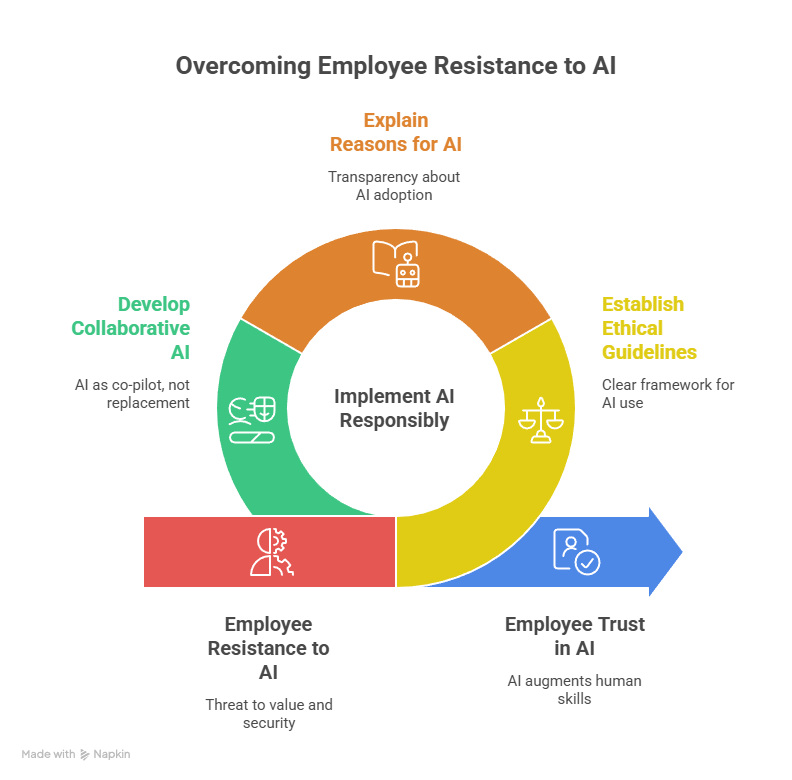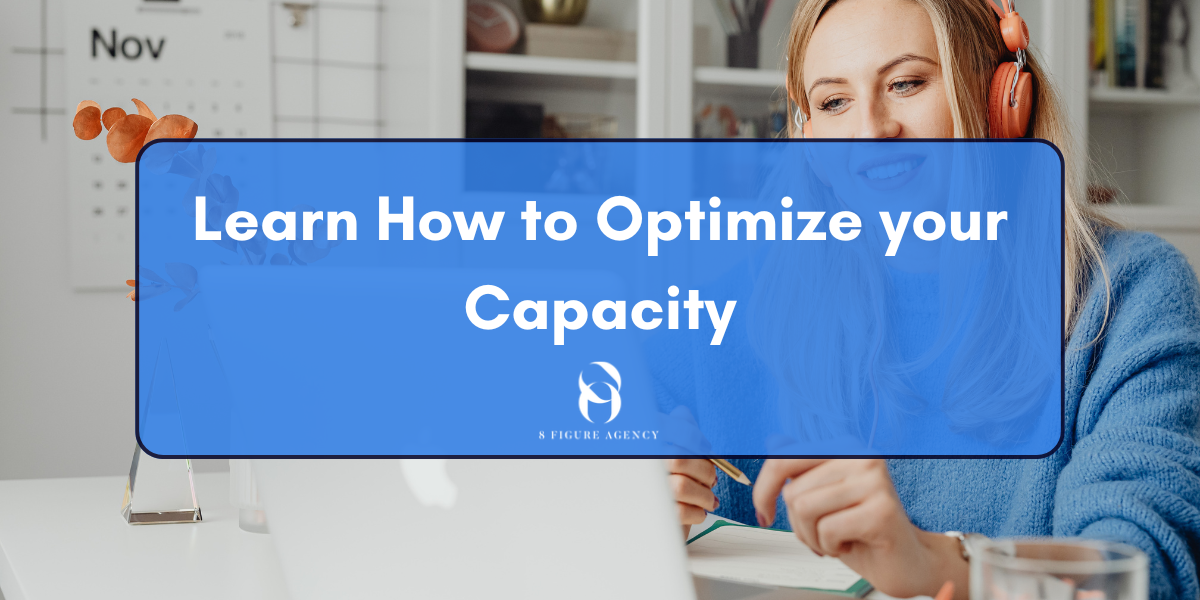How to get your Team to Accept AI
Share now

The integration of Artificial Intelligence has become a present-day business imperative for efficiency and growth. For ambitious founders and agency leaders, the challenge is the human element: how do you introduce AI without sparking fear of job displacement among your most valuable team members?
The common assumption is that your team is afraid of AI because they think it will replace them. As one of our recent newsletters pointed out, this assumption is fundamentally wrong. Your team is not afraid of AI; they are exhausted from the low-value, repetitive work that AI is perfectly positioned to eliminate. The key to a successful AI rollout is shifting the narrative from replacement to empowerment, and making sure your employees see AI as a collaborative partner, not a competitor.
At 8 Figure Agency, we specialize in developing and implementing tailored AI strategies that have helped clients achieve up to a 70% increase in net margins by replacing repetitive human tasks with agentic workflows in a way that doesn't scare your team.
In this blog we will explore the core reasons why employees resist AI, the strategic pillars for building trust and achieving team buy-in, and a clear path to positioning AI as the upgrade your team has been praying for. If you are ready to stop managing chaos and start building a machine that runs itself, book a free systems audit with our team today.
Why Employees Resist AI and How You can Lead them to Overcome It

Employee resistance to AI is not about the technology's capability; it is about the perceived threat to their value and job security. For high-growth agencies, this resistance is a bottleneck to scaling. The solution is to address the root cause: a lack of clarity and control.
How to Implement AI Responsibly and Establish Ethical Guidelines from Day One
The first step in building trust is establishing a clear, ethical framework for AI use. This is the technical and engineering-driven approach to change management. Transparency about what data is used, how decisions are made, and clear boundaries for AI's role are non-negotiable. Your team needs to know that the AI system is a tool under human control, not an autonomous entity making critical decisions in a black box.
This includes integrating the five rules of AI—fairness, transparency, accountability, non-maleficence, and privacy—into your operational policies. By setting these clear governance rules, you as the CEO can demonstrate that the company's values extend to its technology stack.
How to Explain Your Reasons for Integrating AI
As a founder, you must clearly articulate the "why" behind the AI adoption. The goal is not to cut staff, but to increase efficiency and free up your team's time for higher-value, creative, and strategic work. This is the leverage game.
Your team members are currently spending 10–20 hours a week on tasks that add no value like: pulling data, cleaning spreadsheets, compiling reports, and doing repetitive QA. By integrating AI, you are not replacing people; you are replacing the parts of their job they hate. This is how you scale without burning everyone out and achieve the 2–5x business growth you are aiming for.
How to Develop a Collaborative AI Environment
Position AI as a tool that augments human skills. The most successful AI implementations integrate the technology into workflows in a way that requires human oversight and collaboration. This reinforces the idea that the human/AI team is stronger than either alone.
For example, instead of having AI write a final report, have it draft the first 80% and summarize the key data points. The human expert then applies their judgment, context, and strategic insight to refine the output. This approach validates the employee's expertise and ensures that the AI is serving the human, not the other way around.
8FigureAgency helps you build the AI agents that actually move the needle for you. We automate the grind and scale your output without adding headcount. We set up the full AI “brain” behind your business so your workflows run themselves and your team stays focused on high-value tasks. Turn bottlenecks into automated systems and unlock entirely new service lines powered by AI.

A Slack Ready Message for CEOs Looking to Kickstart AI Workflows
If you want people to actually trust the AI tools you roll out, you have to set the tone early. Clarity, transparency, and a bit of straight talk go a long way. Here’s an example message of how you might communicate this to your team:
''Hey team, I want to kick this off by setting a clear and ethical foundation for how we use AI internally. Trust starts with transparency, like what data is being used, how the system makes decisions, and where the limits are.
AI is a tool, not an autonomous decision maker. We stay in control. To make that real, we’re building our approach around five core principles: fairness, transparency, accountability, non-maleficence, and privacy. These aren’t buzzwords—they’re the guardrails for how AI operates inside the company.
And just to be absolutely clear, this isn’t about replacing anyone. Your roles, judgment, and expertise stay at the center of how we operate. AI is here to support your work, not to threaten it. If anything, it frees you up from the repetitive stuff so you can focus on higher-value, more meaningful work.''
How to Adopt AI Long Term
Trust is built through experience, not announcements. Your team learns to trust AI only when they see it working in real situations, under real guardrails, with real human oversight. The following pillars focus on the practical steps that turn early skepticism into genuine, enthusiastic adoption.
It’s worth calling out that companies that roll out AI without guidance or rely solely on generic “DIY setups”
fail far more often than those that partner with trusted, specialized vendors. In the study Expanding
AI’s Impact With Organizational Learning by MIT SMR / BCG: only about 1 in 10 companies achieve “significant financial benefits” from AI when using basic infrastructure compared to companies with
trusted AI vendors.
How to Teach Employees to Use and Love AI
The future of work is not about eliminating jobs; it is about elevating them. As a high-end agency, your competitive edge is the quality of your people. You must equip them with the skills to leverage the new infrastructure you are building.
- Provide ongoing training and make AI Fluency a core competency. A continuous learning program has to go beyond basic tool tutorials. This includes training on advanced prompt engineering, critically interpreting AI outputs, and understanding the underlying logic of the systems. This investment signals to your team that you are committed to their long-term professional development, not just short-term cost savings.
- Foster an AI-positive culture where experimentation with AI is encouraged and rewarded. Create internal forums for employees to share their successes, their "AI wins," and their best practices. View learning about new AI tools as a part of their professional development, not an extra task. This cultural shift is what transforms a simple tool implementation into a strategic advantage.
- Establish formal, transparent channels for employees to provide feedback on the AI tools. This makes them feel heard, gives them ownership over the process, and helps refine the AI implementation for better results. When employees feel they are co-creating the workflow, they become champions of the change, not victims of it.
- Bring in AI adoption experts and change management experts to manage this level of organizational change. You are building a "tech-enabled machine," and that requires more than just IT support. Change management professionals are also essential for structuring the rollout to minimize friction. They can help mitigate fear, communicate the vision effectively, and ensure that the transition is phased and supported.
How to Find AI Application Areas in Your Agency
The first step in applying AI effectively is understanding where it can make the biggest impact. Start by auditing your business to identify your most critical bottlenecks, those tasks or processes that slow down growth, waste resources, or introduce errors. Once you know where the pressure points are, focus on optimizing your internal workflows to ensure your team is operating efficiently before introducing AI.
Then partner with vendors you trust to develop AI solutions that actually deliver results. Avoid chasing shiny tools or hype; the most successful AI implementations come from collaboration with experts who understand both your industry and the practical challenges of integrating.

Want to Future Proof Your Agency?
The successful integration of AI is fundamentally a leadership challenge, not a technological one. By prioritizing transparency, investing in upskilling, and positioning AI as a powerful co-pilot, you transform employee skepticism into enthusiasm.
The successful integration of AI is a strategic move that delivers 50–70% net margins via automation. By replacing the parts of the job your team hates, you free them to focus on the work they love, leading to higher job satisfaction and greater client value. This is the leverage game. To begin building your own shared intelligence network and secure your competitive edge, Book a Call with our team to discuss a custom AI infrastructure build-out. We don't just consult; we build the machine that builds your agency.



